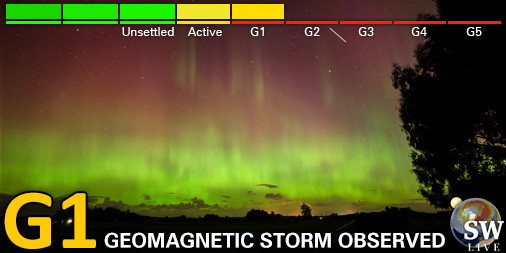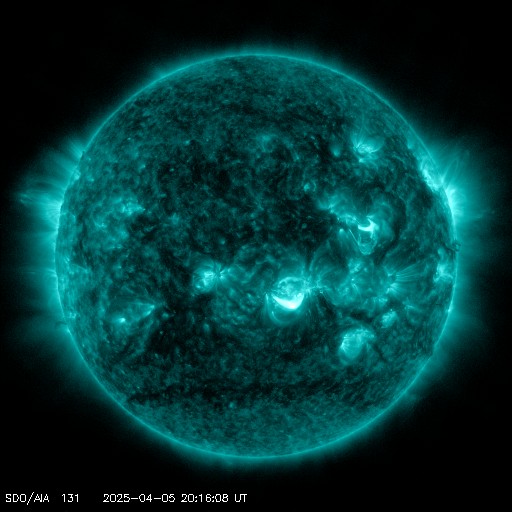Viewing archive of Sunday, 18 August 2013
Daily bulletin on solar and geomagnetic activity from the SIDC
Issued: 2013 Aug 18 1225 UTC
SIDC Forecast
Solar flares
Eruptive (C-class flares expected, probability >=50%)
Geomagnetism
Quiet (A<20 and K<4)
Solar protons
Quiet
| 10cm flux | Ap | |
|---|---|---|
| 18 Aug 2013 | 123 | 007 |
| 19 Aug 2013 | 120 | 007 |
| 20 Aug 2013 | 120 | 012 |
Bulletin
NOAA AR 1818 produced a complex eruptive event on August 17, resulting in two M flares within one hour: a M3.3 peaking at 1824 UT and a M1.4 peaking at 1933 UT. This complex event was associated with a fast CME (~1000 km/s as seen from COR2 A). The bulk of the CME appears to go essentially westwards, with respect to the Earth, but we might cross the eastern flank of this CME on the second half of August 20. The 10 MeV proton flux rose slightly but didn't reach the event threshold. Flaring activity is expected to remain at eruptive levels for the next 48 hours, with C class flares likely from NOAA ARs 1818 and 1824, and a slight risk of an isolated M class flare from AR 1818. We expect essentially quiet geomagnetic conditions for the next 48 hours. There is a small chance of periods of enhanced activity (unsettled to active) on the second half of August 20, due to the CME of August 17.
Today's estimated international sunspot number (ISN): 074, based on 10 stations.Solar indices for 17 Aug 2013
| Wolf number Catania | /// |
| 10cm solar flux | 125 |
| AK Chambon La Forêt | 011 |
| AK Wingst | 008 |
| Estimated Ap | 008 |
| Estimated international sunspot number | 071 - Based on 18 stations |
Noticeable events summary
| Day | Begin | Max | End | Loc | Strength | OP | 10cm | Catania/NOAA | Radio burst types |
|---|
Provided by the Solar Influences Data analysis Center© - SIDC - Processed by SpaceWeatherLive
All times in UTC
Current data suggests there is a moderate possibility for aurora to appear at the following high latitude regions in the near future
Norilsk, VorkutaCurrent data suggests there is a slight possibility for aurora to appear at the following high latitude regions in the near future
ArkhangelskCurrent data suggests there is a slight possibility for aurora to appear at the following middle latitude regions in the near future
Surgut, SyktyvkarLatest news
Latest forum messages
Support SpaceWeatherLive.com!
A lot of people come to SpaceWeatherLive to follow the Sun's activity or if there is aurora to be seen, but with more traffic comes higher server costs. Consider a donation if you enjoy SpaceWeatherLive so we can keep the website online!

Latest alerts
17:33 UTC - Hemispheric Power Index
The OVATION model predicts the Hemispheric Power Index to reach 51GW at 18:18 UTC
Sunday, 6 April 2025
02:00 UTC - Geomagnetic activity
Minor G1 geomagnetic storm (Kp5) Threshold Reached: 01:50 UTC
Saturday, 5 April 2025
20:30 UTC - Geomagnetic activity
Minor G1 geomagnetic storm (Kp5) Threshold Reached: 20:20 UTC
20:24 UTC - Solar flare
Moderate M1.05 flare
20:09 UTC - Radio Blackout
Minor R1 radio blackout in progress (≥M1 - current: M1.05)
Space weather facts
| Last X-flare | 2025/03/28 | X1.1 |
| Last M-flare | 2025/04/05 | M1.0 |
| Last geomagnetic storm | 2025/04/06 | Kp5 (G1) |
| Spotless days | |
|---|---|
| Last spotless day | 2022/06/08 |
| Monthly mean Sunspot Number | |
|---|---|
| March 2025 | 134.2 -20.4 |
| April 2025 | 148.7 +14.5 |
| Last 30 days | 132.7 -9.9 |





